#really if star wars was more ralph mcquarrie than it ended up being
Text

The Rise of Sira - Aesthetic
╰┈➤ kind of star wars, kind of not. cooler, i would say.
#fic: the rise of sira#fd: outer range#scifi au#aesthetic#fic moodboard#really in my head#the aesthetic of this is based off of the creator#a movie that isnt even out yet but i ADORE the look of#really if star wars was more ralph mcquarrie than it ended up being#and i think thats neat
12 notes
·
View notes
Text
I got a good feeling about "The Acolyte"
Not even kidding. Like, I've spoken before about why I'm wary of it.
George Lucas' Star Wars is something that intentionally has black and white morality, rather than shades of gray. Those movies are meant for kids and projecting a "gray" morality onto them then proclaiming it was George's vision all along is doing so in bad faith.
The narrative of the Prequels doesn't frame the Prequel Jedi in as negative a light as Leslye Headland, Dave Filoni, etc etc do.
See here for more details, but bottom line: yeah, a show that has a darksider as the underdog is bound to demonize the Jedi (who are the actual underdogs in the Prequels), and obviously that rubs me the wrong way.
BUT.
The trailer looks fucking cool. It really really does.
youtube
And more importantly? I've done some research... and Leslye Headland is ticking a lot of good boxes, in my book.
1. The Acolyte won't be a 10-hour movie.
I've criticized Disney Plus shows before, explaining that a big source for most of their issues is that these series are being structured as "long movies" rather than, y'know, actual shows.
But in this interview with Collider, Headland addresses that: it'll be a series. Not a long movie that you need to watch across four weeks.
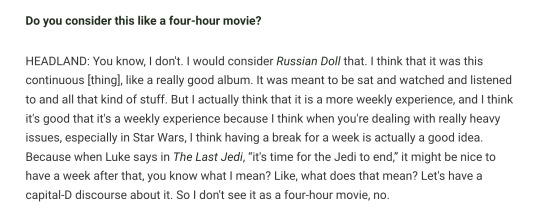
Thank God. You have no idea how much that comforts me. Finally a showrunner who's, y'know, actually running a show.
And this goes hand in hand with what she told IGN, here, about how she's going about building suspense.

Yes! Exactly! That's how it's supposed to be!
Like, compare this to Baylan Skoll's storyline in Ahsoka.
In no possible way was that emotionally-fulfilling. For 8 episodes we had no idea what he was after, and the season ended where we still don't know. What does he want? What is he after? Your guess is as good as mine, it's something Mortis-related.
So yeah. Maybe getting the Emmy-nominated trained screenwriter on board to run this was a good idea.
2. Maybe the Jedi will not be as demonized as I originally thought.
Don't get me wrong. 80% of what she says about the Jedi makes me cringe. It's the typical fan's interpretation and y'all know I disagree with that interpretation.

It's painful to see her refer to the Jedi as an institution (not how the Prequels' narrative frames them) and to see her frame "Balance" in the "oh there's so many of them and just two Sith, that means the Force is out of balance" meaning... but at least she acknowledges the Jedi are a benevolent institution.
They're not an "elitist force hiding in their ivory tower" as others have described the Jedi.
Moreover, there'll be a variety of Jedi POVs, many personalities.
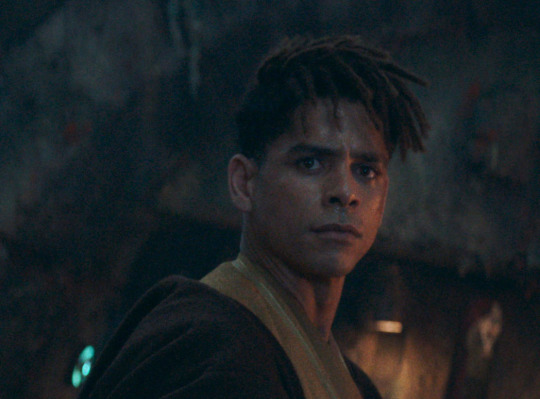
Yord Fandar, is described as a strictly by-the-book Jedi Knight and guardian from the Jedi Temple, is an overachiever and a rule follower.
The question now becomes: will the narrative frame him as "your typical Jedi" or is it just this one guy? I'm hoping it's the latter.
I also like how her reasoning goes re: Jedi drawing their lightsabers.
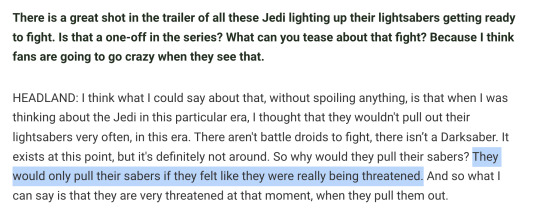
Which explains the hand-to-hand combat seen in the trailer.

This teenager is coming at Carrie-Ann Moss with a dagger, of course the Jedi won't draw her saber.
3. She's a fan of Star Wars... but a screenwriter first.
You can tell in the interviews she's a fan. She's using words like "BBY" and "EU" casually. In the above-linked interviews she's bringing up the Nightsisters, Timothy Zahn, The Clone Wars, she mentions she has a tattoo of Ralph McQuarrie's concept art of Leia, the High Republic books, etc.
She's done her homework. She's a fan.
But the vibe I'm getting from these interviews is that she's weaving in these various lore-elements in a more organic way, rather than in the "fan-servicey" way Dave Filoni has been doing in his shows.
The references and Easter Eggs will be there, but the narrative won't bend over itself just so you can get it. Crafting a good story comes first, and Andor is a beautiful illustration of why this is true.

Which is why I was never bothered about one of the writers never having watched Star Wars before getting the job. You need those fresh eyes when you're tackling something of this scale.
That makes sense to me. Maybe it's because of my own screenwriting experience, but yeah. That out-of-the box perspective is precious.
And like, obviously, that writer watched the films eventually, but for some reason everyone who bitched about Headland omitted that detail and opted for a more bad faith interpretation.
Hm. Wonder why.
Maybe it's the same reason that months ago this clipped audio circulated socials without context, in which she debates whether Star Wars only came from George Lucas and only Lucas is the key.

The FULL context of that interview reveals that she's actually:
debating the "autheur director" myth and positing that it was achieved by a collective of excellent filmmakers and craftspeople that George was skilled and smart enough to recruit...
the studios now think it's a simple as hiring one guy and throwing money at him, because they have no idea what the fuck they're talking about. See Napoleon (2023) for example.
Yes, she also does a jab to the Prequels, which speaks to the generation of fans she's a part of... but overall she's giving Lucas props whilst also stating an ideological difference, that's it!
George is a proponent of the "autheur" theory, Leslye isn't.
However, guess what, in like half the talks George gave post-selling Star Wars? He's giving shoutouts to everyone who helped make the first film, even remembering their names.
So I'm not even sure he'd vehemently disagree with Leslye, in fact they'd prolly have a conversation about it and immediately bitch about how stupid studio executives are :D
But that's not as incendiary, is it? Again, the more I do the research, the more it feels like the reason most of these influencers are hating on her is purely sexist.
I mean, on IGN she's even acknowledging that she does plan on taking stock of fan reactions for Season 2.
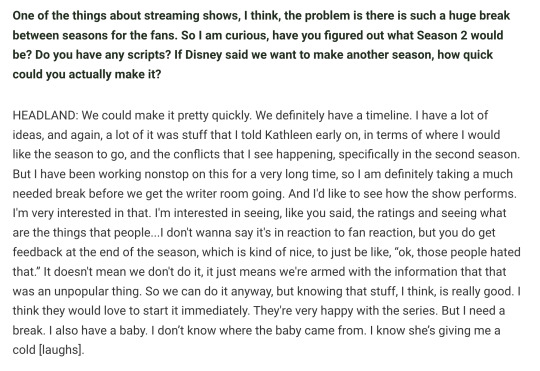
It's not a guarantee that she'll incorporate the feedback, but at least that's more consideration than, say, JJ Abrams or Rian Johnson gave the fandom.
She's even bringing the moral ambiguity that the Gray Jedi-loving edge-lords love so much.

"No, she's a woke feminist! Anything she does is evil! Eww, girls!"
🙄
Needless to say... I'm gonna give it a shot.
I think it's gonna be a good show, I think it's gonna be a solid story.
I'm crossing my fingers that they won't as biased against the Jedi as it seems they'll be. Even if they are... if it's still an enjoyable experience, I'll gloss over it.
As @gffa states in this post:
Worst case? It's not a story from George. I can dismiss it from my headcanon without a moment's hesitation :D
155 notes
·
View notes
Photo
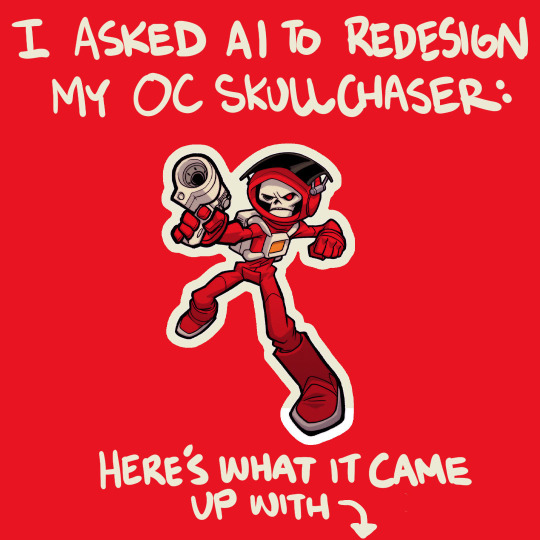

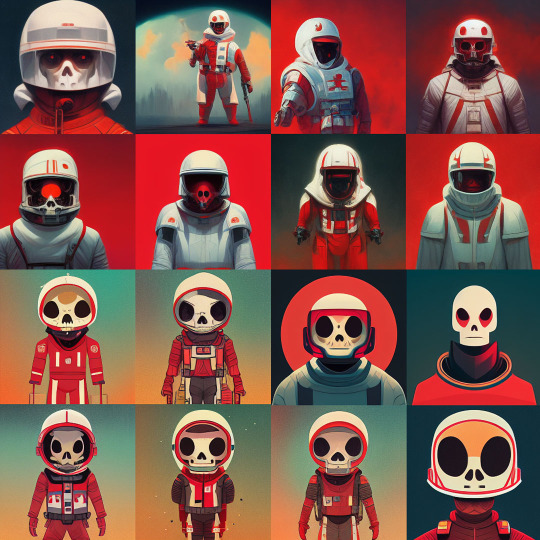
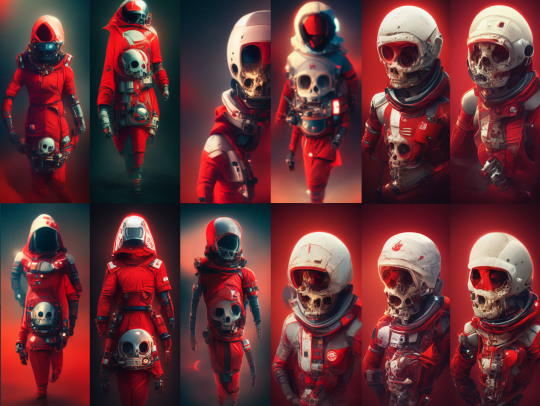



First off, for anyone who needs a primer on AI Generated Art here's a concise video on the subject to get you up to speed: LINK
I used Midjourney I started out with these prompts to see what I would get: Astronaut with a skull head +skull + skeleton + red spacesuit + character design + full body + red + sci-fi + star wars + Ralph McQuarrie + Jake Parker, cartoon, cartoon network, adventure time style.
Then I thought I'd mix it up and see what prompts like octane render + 3d would give me.
I didn't like what I was getting so I went back to my original prompts but added rubberhose animation + pixar + disney + 3d.
The results were better, so I asked for more variations. When I got them I decided I was getting diminishing returns and called it a day. Lots of interesting ideas to put into my design, but no one design really felt like it nailed the vibe I got from my original design.
After this experiment here's what I think:
1) AI Art Generators will only become more powerful/capable. So wishing it away is a waste of time. The only path forward is figuring it out how to implement it and how to regulate it.
2) With revolutionary technology comes a reorganization of status and power. The status quo HATES this and will do almost anything to stop it from happening.
AI Generated Art shifts the power (and wealth) of creating images from people who have training, to people who don't.
This reorganization happened in the 2000s when programs like Maya, 3D Studio Max, and Photoshop made art creation a lot more accessible to people who couldn't paint traditionally, or sculpt clay.
It allowed places like animation studios to be havens for creative people to make art who might not have been able to draw really well. Which really upset people who had trained to animate in 2D on paper, and who studied classical painting techniques. Which leads me to 3:
3) Not everyone who is creative can make art, and not everyone who can make art is creative. The creative people who could also adapt and learn new tools absolutely thrived in the new digital art world.
A lot of the art I've seen generated from AI is a lot like hearing someone impersonate English but who doesn't know the language. It sounds right, but they aren't actually saying anything.
4) I see these AI Art generators as tools. Another resource for creative people to add to their toolbox to make them even more creative. Or at the very least, make their job easier.
5) AI isn't an end to end problem solver for productions. There's still a needs to be an artist to translate it into something usable. Someone needs to interpret AI art into something a modeler can model, or set designer can build.
Example: After a producer plugs a bunch of prompts from a script into Midjourney they take it to the art dept. The crew gets a brief from an art director and instead of a lot of back and forth, the art director points at a page of AI art and says "Make it look like this"
6) Questions I’m still thinking about:
- Do these AI Art Generators actually undermine illustrators, photographers, concept artists? Or does it actually elevate these industries?
- Is it bad to democratize something like art creation?
- Who truly benefits from this shift in power? Where is the money flowing to?
- Should artists have the option of their artwork being removed from the AI generator's databases? Or is any art you post online free game? Does the AI generator do anything different than what an artist does who has strong stylistic influences from other artists?
7) I'm still learning about this, and still reading up on all the pros and cons.
I would love to know your thoughts.
We've been discussing it over on the Discord for a couple weeks now: LINK
I also posted this on IG and it blew up. I could not keep up with the comments. Over 750 of them! If you want to get a vibe check on what the broader art community thinks of this check it out here: LINK
-Jake
61 notes
·
View notes
Text
so what did we think of The Bad Batch S1 (spoilers duh)
well that sure was a star wars cartoon sgafsagbxcswvsbcnd i thought it was pretty good when it wasn't very blatant filler, i enjoyed the characters for the most part, and it obviously looks amazing. i feel like a lot of people felt let down by this show not having some profound message, or being super socially conscious. but like. did we really expect that from lucasfilm ?? idk, i don't really feel let down by this or anything, but it mostly was just a standard star wars story. i did end up liking omega a lot more than i thought i would, she was really only annoying in those filler episodes i mentioned earlier. i sorta liked hunter, im not a huge fan of the stoic leader archetype. ALSO WHILE IM ON OMEGA AND HUNTER, PLEASE STAR WARS STOP MAKING THE SAME SHOW. "serious guy adopts funny baby" was already played out even before mando did it. but that's whatever, it didn't really impede my enjoyment of the show. back to characters, i think echo sorta stands out as a pretty odd character in this show, given that he almost always acts exactly like hunter. it's weird and i really think they could've done a lot more with him, maybe get into what he thinks about the situation more, seeing all of his brothers being replaced by conscripted soldiers. wrecker was.. fine ?? i liked that he and omega were just besties but other than that he didn't really have much going on, just the strong dumb one. tech felt very underutilized, which was a bummer because i really enjoyed him in TCW S7, he felt needlessly cold at times, but i did enjoy how he kinda told off crosshair in the finale. and crosshair..... was probably one of my fave characters ?? the way they switched perspectives between him with the empire and the bad batch reminded me a LOT of the story telling in the original trilogy, switching between the factions to show us what's going on on both sides. im confused on what he meant by having his chip removed a long time ago, i really don't get why he'd stay with the empire, like what just made him fucking evil gasvdbsvcgdshvdf. but i thought he was cool, he really stole the show whenever he was on screen. i really liked the stuff with the empire, seeing how they operate. the new disney canon has a LOT of time that they need to fill in, and i really enjoy what they're doing with it so far. something that stuck out to me was the cool bases built into like mountains n shit on remote planets, THAT'S SO COOL and really shows how much other shit the empire had going on. god. the art direction is so good. i reeeeally loved seeing the TK trooper armor be based off of the concept art for stormtroopers, i think that's a good way to adapt the ralph mcquarrie concept art, do it sparingly (unlike rebels lol) one thing i DISLIKE HEAVILY is the reliance on prequel era stuff in modern star wars. i know im just a little hater but i really dislike the prequels and really want to see more stuff taking place during the galactic civil war/after the sequels. although this soooooorta gets a pass bc it's during the dark times so. whatever. uh. i think that's all i really have to say. this is really unorganized sorry. i enjoyed most of the main cast and the antagonists, the story driven episodes were really great, the filler was not so great, and the overall aesthetic of the show is just. mwah chefs kiss. I AM GIVING THE BAD BATCH SEASON 1 A......... 7/10
okay goodbye forever now
#the bad batch#bad batch spoilers#tbb#hunter#echo#tech#wrecker#omega#crosshair#clones#empire#star wars#stormtrooper#the clone wars
6 notes
·
View notes
Text
For the grand finale of Knock-Off Vaders Week, we’re digging deep into the earliest drafts -- or rather, their comic adaptation! On Thursday I reviewed Dark Horse’s first Star Wars comic, and today I’ll review one of their last.
“The Star Wars” is an ambitious 9-part comic series that combines George Lucas’ messy original ideas with aesthetics from the finished films and brand-new designs by a very hardworking Mike Mayhew. The series peels back layers of wise decisions to get that raw Ralph McQuarrie energy. The end result is thorough, gorgeous, and tedious. As an artifact, I respect it; as a story, it stinks (with one exception). It’s a curious way to read a historically valuable, uh, string of ideas.
The series is a rare sort of alternate universe between the real one and the galaxy far far etc. -- a Star Wars story ordered, for once, not by canon but by wild brainstorming, the spaghetti peeling off the wall before your eyes. It makes you think about the process of storytelling -- a thing I think Disney could benefit from, judging by the rushed and haphazard way they’ve been cooking up their stuff lately.
I’ve never seen such a painstaking adaptation of a such an inferior draft as “The Star Wars.” Lucas stans, beware: the hero is a real asshole. But what about Vader? As far as I can tell, Vader is split into at least four characters. Cue the piccolo solo in Star Spangled Banner as we set off the last batch of KOV fireworks.
1. Darth Vader
He’s just a guy named Darth Vader. First name Darth, last name Vader, as God intended.

He does have the hat in one scene.

I feel a little bad for the guy, with a name like that and nothing to show for it. Pour one out for Darth Vader (disambiguation).
2. Kane Starkiller
The father of the hero, Kane is a real cyborg’s cyborg:

If the Vader we know and love is a fascinating moral dilemma, Kane is a nice guy who is kinda sad. Though he’s far from a villain, he has a lot of other things in common with Vader: machinery, self-sacrifice, a Jedi past. And, crucially, unlike nearly every other knock-off Vader, Kane fucks.
3. Unnamed Sith

This KOV is a little confused, but he’s got the spirit. I like how they went back to the roots with the Japanese mask design, while still being absolutely ridiculous and pointy about it.
It’s a bit of a Warb Null situation, where this guy stuns and wows on the cover, then shows up for a second and quickly kicks the bucket.

He beats Warb’s record of 9 pages. He is only alive for one! (And yet he still accomplishes more.) A worthy KOV!
4. Prince Valorum
Remember how I said the story of “The Star Wars” stinks, with one exception? Prince Valorum is that exception.

Shut up, Darth. A QUEEN APPROACHES!

Stone cold sober, as a matter of fact!
The best thing about Valorum -- besides the fact that he’s a prince, and that his movie counterpart is a real nobody, and just his whole look -- is that he talks about Sith traditions in a way nobody else does. He’s, like, a Klingon?

Valorum’s notions of honor lead to a sexy little duel. He really vibes with the Jedi, ultimately uniting with him against the normies and the robots. (All of this happens in the very last issue, by the way.)
This snobby attitude makes him the only knock-off Vader who, as far as I can tell, shares one of Vader’s best and most neglected traits: his disdainful piety. Vader respects the Force, and he hates the non-believers. To this kind of Sith, even a Jedi is better company than an atheist.
There is one major ideological difference between Vader and Varlorum:

Valorum’s a fucking prude!
“The Star Wars,” issues 0, 1, 3, and 8. Dark Horse. December 31st, September 4th, November 6th, 2013; May 28th, 2014. Writer: J.W. Rinzler, from a draft by George Lucas (100+ posts into this blog, and I finally give a credit to GL). Illustrator: Mike Mayhew.
#star wars#star wars comics#george lucas#darth vader#anakin skywalker#darth vader (disambiguation)#kane starkiller#unnamed sith#prince valorum#annikin starkiller#original trilogy#dark horse comics#j.w. rinzler#mike mayhew#2013#2014#hot sith content#nine panels#new record!#cyborg#dramatic cape#drafts#knock-off vaders#KOVs
68 notes
·
View notes
Text
'The Empire Strikes Back' at 40: What the 'Star Wars' sequel's iconic special effects owe to Ray Harryhausen

By Ethan Altered-States (Ethan Alter)
Yahoo Entertainment, Yahoo Movies • May 27, 2020
https://www.yahoo.com/entertainment/the-empire-strikes-back-star-wars-special-effects-ray-harryhausen-212159259.html
[article was edited for brevity, clarity, and to omit dumb commentary by the original author]

Dennis Muren poses with an AT-AT walker behind the scenes of The Empire Strikes Back. (Photo: Lucasfilm)
-
Both Ray Harryhausen [special effects creator prominent in the 1960s for stop-motion animation] and The Empire Strikes Back (ESB) are celebrating milestone anniversaries this year. 2020 marks the 100th birthday of Harryhausen, the special-effects pioneer behind vintage Hollywood spectacles like The 7th Voyage of Sinbad and Jason and the Argonauts, as well as the 40th anniversary of the second movie in the Star Wars original trilogy.
But they have more in common than the calendar year: The AT-ATs and Tauntauns that walk through ESB are inspired by Harryhausen’s menagerie of stop-motion creatures, from cyclopses to krakens. “They had character, they had performance and they had purpose,” says Dennis Muren, who parlayed a childhood spent watching Harryhausen’s films into a groundbreaking career as a Star Wars F/X legend. “They were wondrous to look at, and the designs of the shots were dynamic. Ray’s work grabbed you emotionally, because it began with him. I’m the same way: being emotionally connected to the performance and design of a character who, simply put, looks really neat.”
Currently the Senior Visual Effects Supervisor and Creative Director at Industrial Light & Magic (ILM), Muren first joined George Lucas’s pioneering visual effects studio in 1976, when it was still making and photographing spaceships in a Van Nuys warehouse. After the success of Star Wars (A New Hope), Muren followed ILM to the Bay Area as Lucas planned for a sequel. “It was the hardest film by far,” Muren says of how ESB came together behind the camera. “Everything just got bigger. The spirit of the film was still fun and adventure, but it had more romance, it had more action, the Empire was bigger and the universe was bigger than we thought on the first movie.”
Muren’s role also expanded with ESB as he took point on directing the fleet of miniatures in the film’s iconic opening on the ice planet, Hoth. With the advent of digital technology still many years away, Muren and his team brought the Rebel’s herd of tauntauns and the Empire’s squad of AT-AT walkers to life by hand. And through it all, he followed the example established by Harryhausen.
“I always think of the Cyclops from The 7th Voyage of Sinbad, who comes out of his cave roaring and angry, and his hands are up because he’s ready to grab one of the sailors,” explains Muren, who later won his first Oscar for his work on the film. (He currently has nine statues, the most of any living person.) “That’s what I always strive to put in my work: that there’s a reason for that creature to be there. You’re not just giving the audience an effect: You want them to feel something from it, whether that’s ‘Oh my God, that’s amazing,’ or ‘Oh, that’s really creepy,’ or ‘Wait, that’s impossible!’”
In honor of ESB's 40th anniversary, Muren walked us through the seemingly-impossible task of making the Hoth sequence, and his own close encounter with his F/X hero.
Yahoo "Entertainment": You said that The Empire Strikes Back was the hardest Star Wars film to make. What was the reason for the degree of difficulty?
Dennis Muren: Well, The Phantom Menace may have been equally difficult, because there was a lot of real groundbreaking work on that in terms of getting all the digital stuff to work. But we had two supervisors on that. For Empire, we had just moved up from Los Angeles, and only brought about 12 people up from the 50 in L.A. and had to hire locally just to get the thing done. All of us working on it wanted to top ourselves, and George had already done that with the designs. The number of lands and battles you saw in Empire was at least five times more than you saw in Star Wars. You had an ice planet and a city in the clouds — how are you going to get that to look right?
Doing any kind of compositing over a light-color background is very, very hard. And the whole movie was full of that in addition to your normal space battles. The vision was so big, and we had a couple of years to do it, but it took us so much time to get the fire to do it and the people to do it. We all wanted what George wanted, which was also what the audience wanted: to show you that this universe is so much bigger than what we saw in Star Wars.
Yahoo "Entertainment": What was the most challenging part of the Hoth sequence specifically?
Dennis Muren: The opening tauntaun shot was one of the most difficult things, and the most interesting. The story behind that was that George had brought back this helicopter shot from Norway [where the Hoth exteriors were filmed], and it was about 200 or 300-feet off the ground with the cameras looking straight down. He didn’t know whether if that shot was going to be necessary to the movie, but at the very end, he said, “Yes, it’s necessary to have this shot. Do you think there’s a way you can add a Tauntaun to this?”
There wasn’t! There were no tracking markers on the ground that would have helped us make the stop motion camera map exactly with the moves the helicopter made, and then we could have combined that with an optical printer. But none of that stuff was there. I thought about building a big model, but I didn’t think it would work with the background. George said, “Well, just think about it.” I spent 15 minutes thinking about it, and figured it out in 15 minutes! I learned an amazing lesson from that: There’s usually an answer, there’s always some way that you can fiddle around with what you know to attempt. If I had stopped thinking at 14 minutes and 59 seconds, we wouldn’t have had that shot in the movie.
Yahoo "Entertainment": The tauntauns definitely feel very Harryhausen in their design and behavior. Did their form match what you could accomplish then with stop-motion or did the stop-motion dictate their form?
Dennis Muren: George had the idea for a galloping horse kind of thing, and I think Ralph [McQuarrie] and Joe [Johnston] worked on the design. I was involved in how we were going to create a setting that looked like it was going to be real, and wouldn’t be encumbered by any of the cameras. I don't know how many shots we had of it — maybe 12 or 15 or something like that, and they were some of the last ones we did. There were a couple that George added right at the very end of that. It was like, “We can finally take a breather after two years, but no, there’s one more shot!”
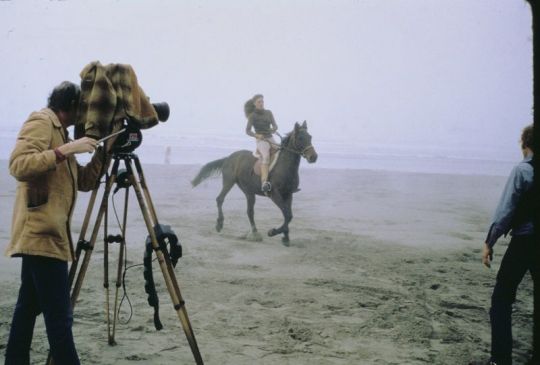
Dennis Muren (behind the camera) filming Suzanne Pasteur (a friend of Lorne Peterson's) on her horse for tauntaun movement reference. (Photo: Lucasfilm)
-
Yahoo "Entertainment": I remember connecting to them very strongly as a kid — I always through they’d be fun to ride.
Dennis Muren: That comes from the design and purpose of it. It doesn’t act like an evil creature: It’s a fairly big, bulky thing and it actually looks kind of cute with a horn and steam coming out of its nose. It’s not a creature that could kidnap you or anything — it’s just a beast of burden. That’s true of all the Star Wars movies: The behavior is familiar, so the audience can relate. Even with the designs of the spaceships; I tried to show how they would bank off to fly to another planet or something, like an airplane would do in the air even though there’s not gravity in space and that would never happen. It looks really neat and you can relate to it.

Luke Skywalker (Mark Hamill) on a tauntaun on the planet Hoth in The Empire Strikes Back. (Photo: Lucasfilm)
-
Yahoo "Entertainment": In terms of the AT-AT walkers, that’s a case where you’re bringing character to a non-living thing. There’s behind-the-scenes footage of the ILM team studying elephants for movement reference.
Dennis Muren: When we saw the designs, we thought they were kind of like big animals. We went to an animal park in Dunn, California, and put a bunch of chalk marks on the elephant and had it walk by left to right and right to left with the camera on. That gave us the weight; those things would have weighed thousands of tons, and we had to make it look like they had gravity or else they were just going to look silly — not as powerful and as evil as they're supposed to look. We also shot the elephants in slow motion to make them look even bigger, and observed traits like how far up the knee goes up and how far forward the body travels. Does the foot just lift up? Does it drop back down again? All that stuff was used as a basis so that when we went to animate, we had a body part to do that.
We also had some really good equipment to look at the frames as we were shooting them and make sure the animation was working well. Like now, there's all sorts of stop-motion photographers, and ours wasn’t done like Ray would have done it where you couldn’t tell if you made a mistake and could go back and say, “Did I move this too far?” We were able to compare and say, “Oh yeah, we did move it too far,” and then change it to move to a better place. So it's probably more of a fluid motion than you might have seen before and that was important. Any sort of chatter in the stop-motion looks like the mechanics of the walkers. They're all mechanical anyway, so there's got to be little bumps and grinds in the motors. So that adds to the feeling, you know?
Yahoo "Entertainment": Besides Hoth, what was your favorite sequence to work on?
Dennis Muren: I don’t know — they’re all so different! [Laughs] I really like the asteroid sequence; that might top Hoth a little bit. It was also really difficult, but a lot of fun to do. George wasn’t interested in the beats of the action, but the attitude. It had to have a certain clarity to see what was going on, which was difficult because the asteroids were coming in from any direction. I did a mock-up of that sequence and realized that everything had to be based on the Millennium Falcon blasting through the asteroids. We came up with the idea of having all the asteroids going in one direction, from one side of the screen to the other, and then you could show how the Falcon makes evasive maneuvers.
Yahoo "Entertainment": Did you get a chance to meet Ray Harryhausen before his death in 2013?
Dennis Muren: Oh, yes. I was probably about 14 at the time, and he used to be in the phone book as was almost everybody else in those days in L.A. I called him up, and he was living up in Malibu, so my mom drove me two hours up to his house, and I met him and his wife. They were just the nicest couple in the world. They invited me in for an hour or two, and we kept in touch. As I got older, I went back to his garage and showed him my home movies, and he showed me some of his early home movies. He was a kindred soul. He later moved to England, so I didn’t see him very often after that.

Special effects legend Ray Harryhausen working on a model for a Clash of the Titans character. (Photo: Courtesy Everett Collection)
-
Yahoo "Entertainment": Did he ever visit you while you were making Star Wars or Empire?
Dennis Muren: No, but I did see him while I was working on Dragonslayer. We were at the same studio in England, and he was making Clash of the Titans. I think I brought him by to show him the dragon, and the rear-projection work. We were working on the next step beyond stop-motion, which was the combination of animation with a motion-controlled motorized camera. He didn’t entirely relate to that, and I can understand why: It could take five days if you’re lucky to get a full shot. At the end of the day, [his method] didn’t have quite the realism that ours ended up having, but he also had the energy to just get in there and grab the figure with his hand and spend the next eight hour animating it.
After Empire and things like the Tauntaun sequence especially, I realized that we needed to get away from stop motion and try and look for something else. I would say that we didn't get the tauntaun to move quite as much as we wanted to, and there were some shots that we didn’t quite finish. But George was utterly accommodating about everything, and there was a feeling of real accomplishment when it was all over. Empire just opened everything up: You can see there’s a lot more stories you can tell, and they’re still going on.
#star wars#empire strikes back#empire40th#ray harryhausen#george lucas#lucasfilm#yahoo news#stop-motion#80s movies#i love the 80's#denis muren
4 notes
·
View notes
Text
Star Trek: Discovery - ‘Context is for Kings’ Review
By Mark Greig
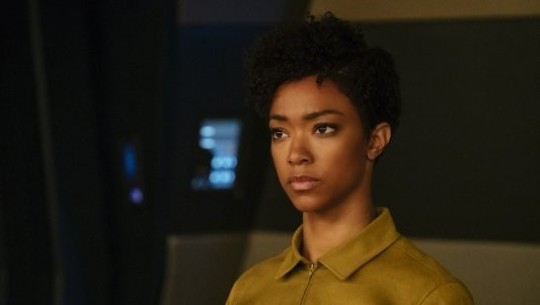
"We are creating a new way to fly."
After last week's extended prologue, this was our first glimpse of what an actual episode of Star Trek: Discovery will look like.
Welcome aboard the USS Discovery, a mysterious ship full of mysterious people doing mysterious things mysteriously. Thrown into this, under suitably mysterious circumstances, is Michael Burnham, six months into her life sentence for mutiny and sporting a new curly prison hairdo. Now something of a Ro Laren/Tom Paris-ish figure, Michael's not interested in getting involved in whatever mysterious shit the crew of Discovery are up to. She just wants to keep her head down, go back to prison and serve her time. That's what she says, but that isn't what she does. She wasn't even on Discovery a day before she decided to break into the secret labs and have a nose around, which was exactly what Captain Lucius Malfoy expected her to do.
It is clear from these first three episodes that Discovery is not going to strictly adhere to the pure Utopian view of the future that Gene Roddenberry envisioned and nothing seems to encapsulate that more than the character of Captain Gabriel Lorca (played by the always wonderful Jason Isaacs). In previous Star Trek shows the captain was always a reassuring presence, the emotional and moral centre of the show, and the one person we could always rely on to do the right thing (or in Sisko's case the wrong thing for the right reason). But in Lorca we have a captain who is untrustworthy, manipulative, militaristic, probably a dark wizard, maybe has his own personal torture chamber, and could potentially end up being the real villain of this entire series. In short, he is everything that Roddenberry would not want a Starfleet captain to be. And that is by no means a bad thing.
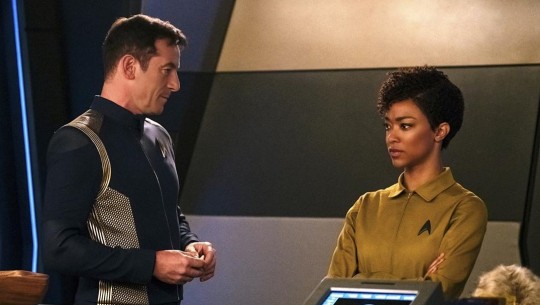
One of the many reasons Star Trek shriveled and died as a television franchise more than a decade ago is because the people making it became unwilling to embrace change or innovation, allowing the franchise to slip into stagnation. To add insult to injury, much of the former talent went away and made the rebooted Battlestar Galactica, which made Star Trek: Enterprise look practically archaic. It also didn't help that the idiots in charge (Rick Berman and Brannon Braga) thought the only way to keep people interested was to treat their female characters as nothing more than scantily clad figures of lust for horny fanboys. Under Berman and Braga's odious leadership, Star Trek went from being groundbreaking and thought provoking to lazy and embarrassing. It is fair to say that no one misses them.
Which brings us to Discovery, our latest hope for the second coming of Star Trek. We thought it would be the new movies but they really do not stand up well to repeated viewing and after the muted critical and box office reaction to Beyond I doubt we'll be seeing another Star Trek movie anytime soon. Which I really think is for the best because, for me at least, Star Trek has already worked better on the small screen. Television allows for more scope, more variety, and more chances for the secondary characters to shine. Can anyone think of anything memorable Geordi or Crusher did in any of the Next Gen movies?
When Discovery was first announced I hoped that it would be a show that combined the character drama and strong storytelling of DS9 with the clever sci-fi ideas of TOS and TNG. I wanted a show that would be faithful to Roddenberry's vision in spirit, but at the same time unafraid to question or even outright challenge it. I wanted a show that understood that Star Trek needs to change and evolve if it is to survive and thrive in the current TV landscape. 'Context is for Kings' is an episode that does exactly that. I'm not saying it is up there with the very best of those shows, but this is exactly what I was looking for from a modern Star Trek series.
One thing I really liked about this episode is how it explored the inherent contradiction of Starfleet itself. This is a military organisation with a military hierarchy that's stated mission is one of peace and exploration. Starfleet officers are meant to be explorers first and soldiers only when necessary, but we see how quickly that gets switched around when the existence of the Federation is threatened. In peace time the Discovery (and its late sister ship) would've been a ship of pure research, but in war time it becomes a mobile Manhattan Project, pushing scientific boundaries to give the Federation the edge in the war with the Klingons.
One thing I didn't like was how quickly they rushed through the mission on the Glenn. They could've done a whole episode about Michael, Stamets, Tilly, Commander Cylon and the red shirt Mulder and Scullying their way around the dark, blood splattered corridors of Discovery's sister ship. Instead, the whole thing was over and done with in barely 10 minutes. Because of this, the entire mission felt shoehorned in just so Michael could have a selfless hero moment and slip in some Fringe style body horror. Mind you, I did find that shushing Klingon a lot funnier than I should've.
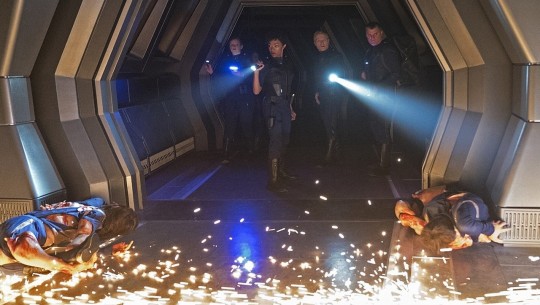
Where Were They Then
Seeing as Discovery is set ten years before 'Where No Man has Gone Before' I decided to skim through Memory Alpha and put together this handy little guide of what all the major Star Trek characters alive at the time were up to.
— James T. Kirk was 23 and an ensign in his last year of a five-year officer training program at Starfleet Academy. After graduating Lt. Kirk would be assigned to the phaser station aboard the USS Farragut.
— Spock was 26 and serving as science officer aboard the USS Enterprise under Captain Christopher Pike.
— Dr. Leonard McCoy was 29 and had recently ended his relationship with Nancy Carter ('The Man Trap').
— Montgomery Scott was 34 and serving as an engineer in Starfleet.
— Pavel Chekov was 11 and no doubt learning about how everything ever made was Russian.
— It is unknown how old Hikaru Sulu and Nyota Uhura are during this period or what they were doing, but it is likely they were both in high school.
— The Dax symbiont's current host was either Emony or Audrid.
— I haven't got the foggiest idea how old Guinan was or what she was doing, but I imagine it involved the buying of lots and lots of really big hats.
— And Q was no doubt off annoying some species somewhere.
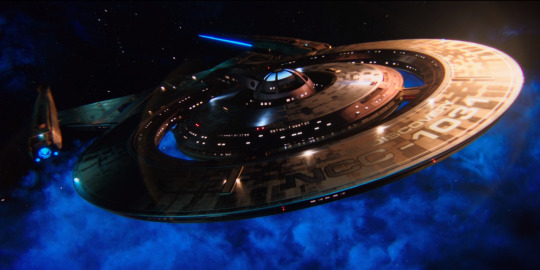
Notes and Quotes
— The design of the Discovery has been tweaked since the first teaser trailer was released. The ship's look was based on Ralph McQuarrie's redesign for the Enterprise for the unmade Star Trek: Planet of the Titans.
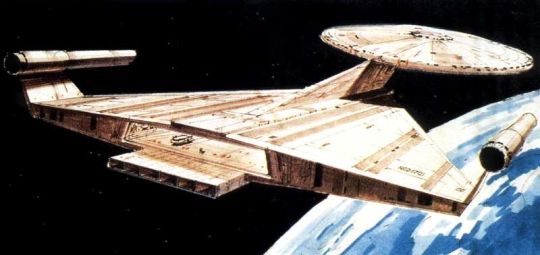
— For those of you interested, the Discovery is a Crossfield class ship.
— Amanda's fondness for Lewis Carroll comes from the animated series episode 'Once Upon a Planet.'
— As well as Captain Lorca, this episode introduced us to two other members of the main cast: Paul Stamets, an astromycologist and your typical asshole genius who is not at all happy about being press ganged into the Federation's war effort, and cadet Sylvia Tilly, the offspring of a rainbow and sunshine. Because she's so adorable, and her friendship with Michael shows a lot of promise, I'm willing to overlook the fact she is a walking collection of nerd cliches.
— Loved Saru showing Michael around while munching blueberries.
— One of the things that has always bugged me about every Star Trekseries is how the crew always beamed into hazardous situations in their regular uniforms. I am happy to see that this show is dispensing with that.
— Tilly with her hair down made me think of T'Pau and I don't mean the Vulcan.
— I'm assuming the reason the ship isn't swarming with them is because Lorca had his Tribble neutered.
— The uniforms have pockets. Pockets!!! Now that truly is revolutionary.
— I don't trust Commander Cylon.
— Anyone else think the black badge dudes are connected to the ones from Wynonna Earp? I know they are probably Section 31, but what if black badge and Section 31 are one and the same? Then when can we have a crossover and see if even the universal translator can make sense of what Doc Holliday is saying.
Lorca: "No matter how deep in space you are, always feels like you can see home. Don't you think? Maybe it's just me. Forgive the lighting. The lack thereof. A recent battle injury. There's nothing they can do if I want to keep my own eyes, and I do. I have to suffer light change slowly. I like to think it makes me mysterious. No?"
Tilly: "Wow, is that a book?"
— Somewhere the ghost of Rupert Giles is weeping.
Three out of four Beatles' cover bands.
#Star Trek#Star Trek Discovery#Michael Burnham#Saru#Sylvia Tilly#Paul Stamets#Gabriel Lorca#DIS#Disco#ST:Disc#Star Trek Reviews#Doux Reviews#TV Reviews
4 notes
·
View notes
Text
Best Star Wars Trading Card Sets to Celebrate Lucasfilm’s 50th Anniversary
https://ift.tt/eA8V8J
This article is part of our Collector’s Digest content series powered by:
This year marks the 50th anniversary of Lucasfilm. To say the corporation that George Lucas founded as a way to realize his artistic vision forever altered popular culture is akin to understating the heat of the sun. Indeed, it is incomprehensible to think of a world without Lucasfilm and the wonders it has given us over the course of the past half century.
What initially began as a way for Lucas to pursue his creativity outside of the auspices of the Hollywood machine is a fascinating story in and of itself – one whose irony is impossible to overlook given how the independent filmmaking ideologies held by the company eventually gave way to the biggest film franchise in history. And that’s not to overlook the significant artistic and technological achievements Lucasfilm unleashed, Ark of the Covenant style, with the Indiana Jones franchise.
Lucasfilm is an embedded part of the mainstream fifty years later. Yet the company has never strayed far from its initial mission statement of creating works that elicit genuine wonder. The fact that Lucasfilm productions often offer profound commentary on the human condition – even when a huge chunk of the characters who populate the Star Wars universe aren’t human – is just another example of the creative alchemy they continue to conjure.
As we celebrate this milestone anniversary, we wanted to share with you some of our favorite merchandise spawned by the company’s releases, namely Topps trading cards. (Besides, Lucasfilm and its consumer output has an ouroboros-like relationship at this point). Below you’ll find an assortment of trading cards lines that Topps has issued inspired by the various Star Wars films and television shows.
All of these offerings represent not only how Lucas and Lucasfilm deconstructed and rebuilt science fiction into a far-reaching phenomenon but also the simple ways that collectibles are a part of our shared history. Maybe you have fond memories of buying a pack of The Empire Strike Back cards off of your local ice cream truck, or warm reflections about schoolyard discussions about Jabba the Hutt spawned by trading Return of the Jedi trading cards. These memories are a part of why the Star Wars saga is so meaningful to fans the world over, and we have Lucasfilm and Topps to thank for this. And thankful, we truly are. Here now, is a look at some of Lucasfilm and Topps’ greatest collaborations.
Topps Star Wars Unopened Trading Card Box
Price: $2,000 – $4,000
Impossible though it may seem from a 2021 perspective, there was a time when Star Wars collectibles were downright difficult to find. Kenner’s infamous Early Bird Certificate issued for Christmas of 1977 was essentially an empty cardboard sleeve that promised action figures that didn’t technically exist yet. Other quickly produced merchandise like inflatable lightsabers (which, admittedly are kinda badass), puzzles, and a board game helped temporarily quell the desire for all things related to a galaxy far, far away.
Of the initial products, the one that has endured the longest is Topps’ various trading cards. For a mere 15 cents, would-be Star Warriors could get several cards with full color images from the film, a dazzling sticker – you’d feel like royalty if you’d score a Darth Vader one – and a stick of gum. These were inexpensive, highly collectible, and super cool. Not only did they help introduce a generation to trading cards, but the five different colored lines that make up the series remain some of the most desired Star Wars collectibles ever. Which is why an unopened box of these cards will set you back a pretty penny. The bragging rights owning one will give you though? Priceless.
Buy a Topps Star Wars Unopened Trading Card Box on eBay here
The Empire Strikes Back Series 3 Unopened Pack
Price: $5 – $30
When it came time for Topps to release card sets for The Empire Strikes Back, the company ramped up the excitement in a manner befitting the source material. There were three separate sets released for the sequel, with the 88-card set in the third series being arguably the most exciting. Why? The third series offered everything from comic styled depictions of characters like Boba Fett and “Probot” to jaw-dropping art from visionary Ralph McQuarrie to deliciously melodramatic captions like “Threepio in a Jam!” and “Dodging Deadly Laserblasts!” Recreating the action of the film on a trading card feels like an impossible task, one Topps was somehow able to achieve.
Buy a The Empire Strikes Back Series 3 Unopened Pack on eBay here
The Empire Strikes Back Full Color Giant Photocards Unopened Pack
Price: $5.99 to $14.99
Back in 1980, Topps pulled off the impressive feat of selling a single Star Wars card for 20 cents. Yes, they really had some cojones to attempt to pull off such a stunt, but this move was about way more than milking the Star Wars cash cow. Each of these 30 “Giant Photocards” from The Empire Strikes Back was a behemoth suitable for locker display and/or framing. Unfortunately, consumers weren’t buying the whole less-is-more thing, and the line evaporated quicker than Luke’s snowy vision of Ben Kenobi.
Buy a The Empire Strikes Back Full Color Giant Photocards Unopened Pack on eBay here
Return of the Jedi Trading Cards Unopened Box
Price: $300 – $500
Let’s be honest, Return of the Jedi was a bittersweet affair. It marked the end of the original Star Wars trilogy, and some viewers found it to be a disappointing wrap up. Add to that the uncertainty of when we would see these characters again, and you’ve got a recipe for some complicated feelings. Not that you’d know any of this galactic ennui from the movie’s merchandise, which paints it as a fun-packed — if somewhat underwritten — conclusion to the Skywalker story. (What little we knew back in 1983, huh?)
The corresponding card line from Topps tended to focus on the film’s biggest moments. In the process, it presented a clear image of what Return of the Jedi truly was: inspired pop entertainment for a galaxy of moviegoers.
Buy a Return of the Jedi Trading Cards Unopened Box on eBay here
Star Wars 3Di Widevision Card Set
Price: $50 – $75
Topps is consistently at the forefront of trading card technology, and this is exemplified by their 1996 3Di Widevision Card set. Building on the Widevision style they premiered the previous year, these cards featured images from Star Wars that replicated their original aspect ratio. More than that though, each entry in the series recounted the film’s story through lenticular images that seemed to pop off of the card. More than a mere novelty, this felt like the evolution of trading cards.
Buy the Star Wars 3Di Widevision Card Set on eBay here
1993 Star Wars Galaxy Unopened Box
Price: $80 – $100
After what seemed to be an eternity but was actually just about a decade, Star Wars started to roar back to life in the early 1990s due to Expanded Universe material like Timothy Zahn’s Thrawn novels and Topps’ Star Wars Galaxy card lines. Enlisting the aid of a diverse array of artists that included Mad Magazine’s Sergio Aragones and poster art legend Drew Struzan, this set – punctuated by rare foil etched chase cards – expanded the parameters of the Star Wars universe in richly inventive ways.
Ever wonder what Chewie did in his off hours? Or how various artists interpreted the Droids? This line answered those questions, and many more. The Galaxy line was such a success that it spawned several sequel lines as well as a 2018 reboot. As amazing as these subsequent lines have been, they don’t have the sheer magic of the 1993 original, which reminded us of how the possibilities of Star Wars were as infinite as the universe itself.
Buy the 1993 Star Wars Galaxy Unopened Box on eBay here
Journey to Star Wars: The Force Awakens Set
Price: $40 – $160
The Star Wars saga is rich with repeating motifs and characters whose paths echo in unexpected and exciting ways. In 2015, Topps released the Journey to Star Wars: The Force Awakens card set to show how the franchise’s past influenced its future. The Force may not always be in balance, but Star Wars merchandising is!
Buy Journey to Star Wars: The Force Awakens Sets on eBay here
The Mandalorian eBay Exclusive Topps Card Set
Price: $50 – $85
If you’ll allow us to get meta for a moment, we’d be remiss if we didn’t mention this release from The Mandalorian that was available last year as an eBay exclusive. Topps gave this 10-card set a retro feel by utilizing a Mars Attacks-esque font and gorgeous retro art that really drives the whole galaxy far, far away point home.
Buy The Mandalorian eBay Exclusive Topps Card Set on eBay here
cnx.cmd.push(function() { cnx({ playerId: "106e33c0-3911-473c-b599-b1426db57530", }).render("0270c398a82f44f49c23c16122516796"); });
The post Best Star Wars Trading Card Sets to Celebrate Lucasfilm’s 50th Anniversary appeared first on Den of Geek.
from Den of Geek https://ift.tt/3xOCmLV
0 notes
Photo

ILM Shares ‘Star Wars Stories’ at Gnomon
ILM’S Paul Giacoppo, Charmaine Chan, and Jay Machado discuss their career paths, making Rogue One, and much more.
From the opening shot until those final moments before the Tantive IV takes off into hyperspace, Rogue One’s visual storytelling takes center-stage in a big way. The credits run long for a reason, and that’s because hundreds of people at Industrial Light & Magic worked tirelessly to bring every major visual to life in a way that felt both “classic” and new at the same time. Last month at Gnomon University in Los Angeles, three of those visionaries brought their work to an audience of eager visual effects students in a special presentation called Star Wars Stories: An Evening with ILM. ILM’s Paul Giacoppo, Charmaine Chan, and Jay Machado brought decades’ worth of experience to their discussion.
Machado was on the modeling team for The Force Awakens’ Millennium Falcon, and created the award-winning Imperial Star Destroyer that we see rise from the shadows in Rogue One. Charmaine Chan spoke of her history at ILM, illustrating how careers grow and change on the company’s campus. Giacoppo is behind some extremely recognizable work that reaches back decades over the history of Lucasfilm and ILM; the crowd was hooked when he showed off his visually memorable “Hulk Smash” shot from Marvel’s Avengers.
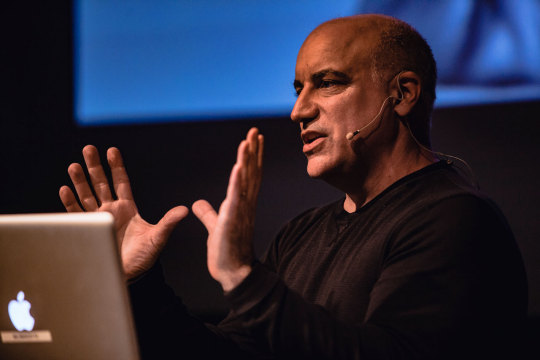
But while their extensive careers could take up an entire editorial on their own, the focus of the evening was visual storytelling, and how ILM created Rogue One. Giacoppo outlined the overall objective of what the team wanted fans to see and understand: “The idea behind our work on Rogue One was that it had to have the visual feel of the classic 1977 Star Wars, but have a new vision as well.”
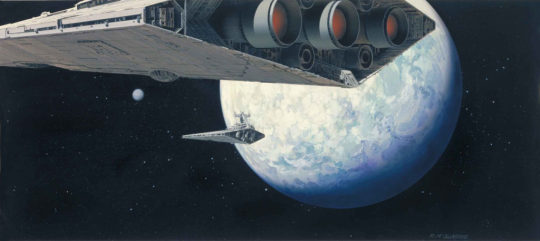
When it came to seeking out inspiration, the team had to look further than the usual standards. They began with concepts by Ralph McQuarrie, Joe Johnson, and several others that defined the look of Star Wars. These angular, expansive, and recognizable styles still reflect throughout Rogue One, but the team looked at what they could do differently as well, because the story in itself was different from the norm. “[McQuarrie and Johnson’s concepts] were part of what the visual language of Rogue One was,” said Giacoppo. “But it was a different kind of movie. It was a true war movie, about people with a mission to complete. So it’s not exactly a ‘hero’s journey,’ and we had to change what we were doing in order to tell this different kind of story.”
Giacoppo dove into set design, then, showing off digital recreations of classic sets that were created by John Knoll, ILM’s chief creative officer and a staple of Star Wars creativity. Knoll, attempting to explain how characters would move through various scenes, created digital set tours practically overnight in order to explain his vision.
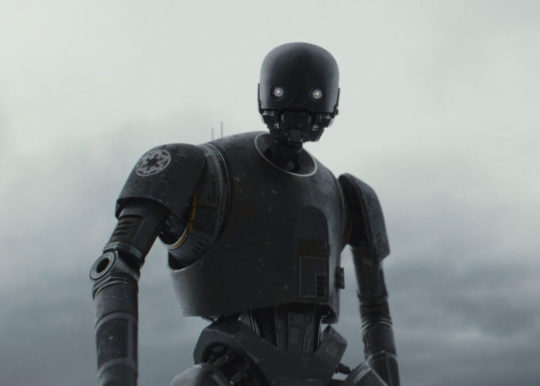
Giacoppo then dove into characters that were created digitally for the film, focusing first and foremost on K-2SO, who he says has been part of the Rogue One story since its original pitch. K-2SO varied greatly from past on-screen droid companions, who were so often cute, or at least a little more friendly-looking. “He’s intimidating, he’s really stealthy, and he’s huge… and he was always an Imperial enforcer droid.
“There was a lot of time spent with the texture artists to get those same materials and weathering we’re used to in Star Wars,” Giacoppo explained, noting the details that showed Kaytoo’s age and length of use.
The team took designing Kaytoo very seriously, spending hours on specific details about how he would emote. The team looked at more eyes than one can count on two hands, then went through tests of how they would move — if at all — and how Kaytoo looked when expressing himself. “There was a big push to have a part of him blink, and to have a part of him move his mouth,” said Giacoppo, noting that such a thing is a rarity among Star Wars droids, who often reflect a much more industrial feel in design than most AI-driven beings within the genre. “But it just didn’t feel like Star Wars. See, he’s all blinking and jittering around… there’s too much going on.” With animation supervisor Hal Hickel’s guidance, the team ultimately went with “this sort of more impassive mask”, said Giacoppo, allowing fans to read and “project” emotions onto Kaytoo as they got to know him.
As a special bonus, Giacoppo showed a tiny clip of K-2SO playing with toys that paired with some very familiar audio from Alan Tudyk’s Wash in Firefly (“Curse your sudden but inevitable betrayal!).

ILM’s Jay Machado, a hard-surface modeler and texture artist, was a welcome and familiar face that evening. As a Gnomon alum himself, Machado’s post-grad years have been more than exciting. For Rogue One, following his Millenium Falcon re-creation, Machado was tasked with creating iconic ship-looks once again. To set the tone for the talk, Machado showed off that iconic opening shot from A New Hope, where the belly of the Star Destroyer sails over the camera in pursuit of Princess Leia’s Tantive IV. “We wanted it to feel like the exact same era,” said Machado. So, his team at ILM went to the root of all builds to recreate and design ships in Rogue One. “For the ships, we went up to the archives, we took lots of photos, we scanned things, stuff like that — all to get the ships to be just right,” Machado told the crowd. “There’s a few people still working at ILM that we were able to talk to, like [long-time ILM VFX artist and supervisor] Dennis Muren, who [shot] much of this originally, and that really helped when it came to making it accurate.
“What I was surprised by is that the original Star Destroyer is only three feet long…a lot of the panel lines are drawn in with pencil. And we wanted to match that so that in a way, you could watch Rogue One and seamlessly start A New Hope.”
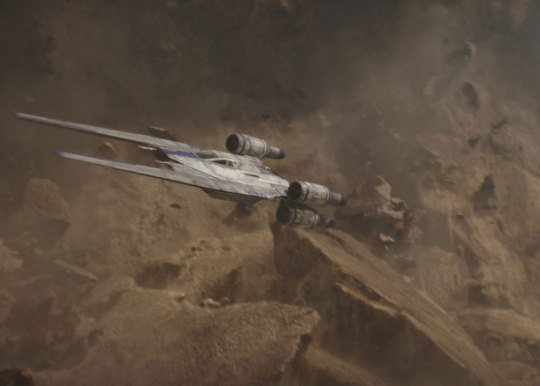
As far as new ships went, Machado noted that the tasks were just as difficult, but worth every grueling second. “Working with Doug Chiang and the art department, we had to design [the new ships] in a way that felt familiar so that they would blend in seamlessly with the ships we know and love.” Machado highlighted the U-wing, Krennic’s ship, and the new TIE strikers, stating that they were kind of meant to “compliment” the U-wing, with forward-sweeping panels and a unique, planet-specific use.
What may have been most exciting was the creation of new ships to the canon, like the Ghost from Star Wars Rebels, which featured on screen twice in Rogue One. “It fell to me to actually [build the Ghost] and it was kind of a secret project,” said Machado. “Well, at first it was a secret. Nobody else was supposed to know about it. I was supposed to do this quickly, and I had to design it in between my daily work so that people within the office wouldn’t start getting suspicious,” he joked. There are panels and pieces that might look familiar, too — parts of the Ghost might look similar to the Falcon, and that’s no mistake.
One other major ship from Rebels that ended up in Rogue One came all the way from the Knights of the Old Republic games, originally. Hammerhead cruisers, which Princess Leia worked with Kanan Jarrus and Ezra Bridger to steal for the Rebellion in Star Wars Rebels, played an integral part in Rogue One, and Machado was among those responsible for their finished designs on the big screen.
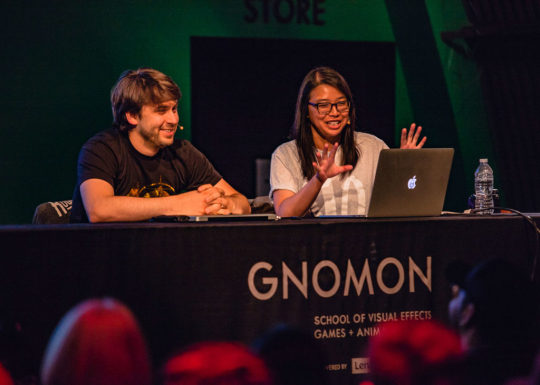
Charmaine Chan’s presentation focused more on the process of growing her career before and after ILM. As an up-and-coming artist who veered off the trail that her parents originally wanted (worry not — they were ultimately supportive either way), Chan hit the ground running by creating work early and producing it every day. Since joining ILM, Chan has worked on more movies than one can count — a once-over of her IMDB page shows credits for Transformers, Captain America: Civil War, Jurassic World, and more. But her beginnings were in Web development.
According to Chan, she learned HTML, CSS+, and more “so that I could build Spice Girls websites” as a little girl. As that hobby grew, Chan broke into graphic design, then Flash animation. (As someone who started her career building Star Wars and N*SYNC fansites, this writer can relate.) “That’s what really started all of this, because I started watching movies closer and learning what it took to compose a full shot. There’s lightning, texture, and all sorts of details to consider, which I found really interesting…it really helped me move into this form of art.” Chan took those skills to the next level, learning visual effects, making motion graphics (“You know, like, DVD menus!” she joked) and eventually applying for a digital research position at ILM. “That gave me a really great overview of what the VFX process is,” said Chan. “I got to touch the shots at the beginning and the end.” From there, she kept working her way into a position at ILM that has grown and spanned over a decade, leading to her work as a compositor today.

The night was a wonderfully informative look at how the story of Rogue One was brought to to the big screen with stunning, modern, yet familiar visuals. One of the biggest surprises for this writer was learning about the sheer scale of people working on each Star Wars film. Hundreds of names scroll down through the credits after every film, but there’s just something unique and different about putting faces to those names and realizing just how many people it takes to make our favorite galaxy far, far away come to life.
14 notes
·
View notes
Text
'Rogue One' Artist Doug Chiang on Early Concepts, His 781 U-Wing Drafts, and What Makes a Design Feel Like 'Star Wars'
yahoo
When Doug Chiang began designing Rogue One (available on Digital HD now and Blu-Ray April 4), the stand-alone Star Wars film was just a concept with no script or director. But that’s all that Chiang needed. As soon as he heard John Knoll’s idea for a Death Star heist film, the Rogue One production designer (who is also the VP and executive creative director of Lucasfilm) began sketching out characters, ships and locations for a Star Wars adventure that would take place immediately prior to the events of Episode IV: A New Hope. He knew how to build a world out of just a few fragments, because he’d learned almost 20 years earlier… from George Lucas.
“That’s how I started with George when he hired me to head the art department for the prequel trilogy back in 1995,” Chiang tells Yahoo Movies. “He didn’t have a script or a story, but he knew of things… he would just give me tiny fragments of information, deliberately, so that I wouldn’t know too much, and then I would just throw out a bunch of different ideas and he could kind of hone it in quickly like that.”

“Cargo AT-AT Variant Version 1A,” by Lucasfilm’s Thom Tenery, depicts the climactic battle on Scarif, before the walkers were officially called AT-ACTs. (Image: Lucasfilm/Disney)
Lucas had always seen art as a crucial part of story development for Star Wars. While working on the original trilogy, Lucas commissioned artists like Ralph McQuarrie to create designs for planets, characters, and ships that could be a part of his universe. “I love that part of the process because it liberates you to just explore and see what feels right given the story,” says Chiang. “You try something crazy, and it might actually inspire the writer or the director to come up with a new idea.”
Some of the early ideas developed by Chiang and his team included an alien member of Jyn’s crew and a rebel base on the planet Dantooine, where part of Rogue One was originally set. (Chiang’s idea for that rebel base — large, rounded rock formations with hollowed-out layers of sediment that form rooms — was inspired by a McQuarrie concept painting of Dantooine made for the original trilogy, in which the planet is mentioned but does not appear.)

“Hero Ship Version 9” by Lucasfilm’s lead concept artist Matt Allsopp is an early U-wing prototype. Elements of this design were incorporated into the TIE Striker. (Image: Lucasfilm/Disney)
When director Gareth Edwards came on board, he contributed his own ideas for the Rogue One world, including a vision for a new spaceship that would, in Chiang’s words, “be on par with the X-wing or the Millennium Falcon.” That ship became the U-wing, a new Rebel starfighter that looks exactly like it could share airspace with the Falcon — and took the production designers exactly 781 drafts to get right.
“When Gareth set that bar that high, it was very intimidating because I consider the Falcon and the X-wing to be perfect designs,” Chiang explains. “And so our goal [with the U-wing] was really to try to find a design that could be in that same space yet still feel very classic in terms of Episode IV aesthetics, but yet different enough so that it bridges Episode III aesthetics. And at the same time, we had to know that there was a reason why the U-wing doesn’t continue on to Episode IV, that it was an obsolete design. And so you layer all these different factors in there and it becomes very complicated.”
Chiang knew he was on the right track when he showed Edwards a design for a ship with its wings stretching out forward. “He said, that reminds me of Superman with his arms outstretched. It was a very powerful, instinctual feeling that he got,” Chiang recalls. “And that immediately informed me and I was like, ‘OK, that’s what he’s going for emotionally.’ And so I started to use that configuration. From there it was really iteration upon iteration of refinement of those forms, because the minute you change the proportion of one thing, it affects another. Easily half of those 781 drawings towards the end were little changes to find the perfect thing… And at the end I think we found the perfect note, because it actually looks great from all angles. I’m really happy with the design.”

Version 1B of Pao, the amphibian Rebel commando featured in the battle on Scarif in Rogue One: A Star Wars Story, by concept artist Adam Brockbank (Image: Lucasfilm/Disney)
In addition to his work on the prequels and Rogue One, Chiang is a concept artist on the current saga films, including The Force Awakens and The Last Jedi. So he’s uniquely qualified to answer the question of what makes a design feel like Star Wars. Chiang describes striking that elusive balance between a design that feels fresh, yet blends easily into George Lucas’s universe, as his biggest and most exciting challenge. “You can actually almost play it too safe and make everything feel too familiar, and you don’t want to do that because you’re just repeating. You have to add something new to it,” he explains. “Because when you look at the classic films, George brought in something new to each of the films. For instance, Cloud City [in Episode V: The Empire Strikes Back] was such a bold design statement, and if you just judged it from Episode IV, you would say, ‘No, Cloud City is not Star Wars.’ Or Jabba’s barge from Episode VI.”
What unifies these visual ideas, he explains, is a timeline grounded in actual design history. The prequel trilogy draws on design ideas from the 1920s and ‘30s, while the classic trilogy reflects mid-century design through the early ’80s. The aesthetics of Rogue One — the guerrilla troops, the ships — were influenced by Vietnam War design, in the same way that the original trilogy took cues from WWII iconography like Nazi uniforms and dogfights. And the new films have a contemporary feel, while at the same time being grounded in the original 1970s technology — vector graphics, keyboard push-buttons — that established the look of A New Hope.

This striking image, of the Death Star eclipsing the sun over Jedha but launching its fateful blast, become one of the most memorable scenes in the film. (Image: Lucasfilm/Disney)
And of course, it’s important that the designs can be turned into cool Star Wars toys. “I always think, ‘OK, would I want that as a toy to play with as a kid?’” says Chiang. “For the U-wing especially, we were trying to go for designs that hit all the design notes in terms of story, functionality, the aesthetics leading into Episode IV. But then at the end I wanted something that I would proudly show on my desk and play with as a kid.”
Chiang won’t comment on the rumors of new AT-AT designs for The Last Jedi, other than to say that audiences will be “pleasantly surprised.” Meanwhile, fans can turn to the Rogue One Digital and Blu-Ray extras for more of Chiang’s concept art — which may well inspire the Star Wars universe for generations to come.
Read more from Yahoo Movies:
Rogue One: A Star Wars Story Writer Gary Whitta on Alternate Endings, Discarded Characters, and How He Came Up With the Title
Star Wars: The Force Awakens Concept Artist on Creating Starkiller Base and That Dark Knight Crossguard Lightsaber
Rogue One Creator Defends CGI Tarkin; Says Carrie Fisher ‘Loved’ Her Digital Self (But She Won’t Come Back)
#_uuid:380e65ec-b9a2-3f35-af6c-c63bdab289c3#movie art#rogue one#exclusives#_revsp:wp.yahoo.movies.us#movie:star-wars-rogue-one#video#_lmsid:a0Vd000000AE7lXEAT#_author:Gwynne Watkins#behind the scenes#doug chiang#star wars#george lucas
1 note
·
View note
Text
How Darth Vader Got His Groove Back in 'Rogue One' Thanks to Last-Minute Tweak

Vader in ‘Star Wars: Episode IV — A New Hope’ (Lucasfilm)
From the moment he burst onto the blockade runner in 1977’s Star Wars: New Hope, Darth Vader has reigned as one of the biggest, baddest, most iconic antagonists in cinema. But let’s face facts: The Sith lord has largely been coasting on reputation these past 40 years. After all, most of his big-screen career has seen the erstwhile Anakin Skywalker being alternately redeemed in third-act Return of the Jedi heroics or humanized via the prequels’ backstory, which saw him develop from whiny kid to angsty adolescent to disaffected young adult, all too easily manipulated by Palpatine along the way.
But, thanks to Rogue One, Darth Vader is back at his malevolent best, annihilating rebels with a mere flick of his wrist and flash of his lightsaber in the film’s waning moments. However, that climactic scene, which reestablishes Vader’s dark side bona fides, almost didn’t exist. According to editor John Gilroy, the badass action scene was one of the key late tweaks arising from the film’s infamous reshoots. “What was added — and it was a fantastic add — was the Vader action scene, with him boarding the ship and dispatching all those rebel soldiers,” he tells Yahoo Movies. “That was something conceptualized a little later.”
With the Star Wars standalone providing the connective tissue between Revenge of the Sith (which ends with our first glimpse of Anakin-as-Vader) and A New Hope, director Gareth Edwards always intended to bring back the dark lord. As initially conceived, though, Vader was more threat than death agent in his brief appearances — an ominous warning here, a nonlethal Force choke there.
Related: Watch Lego and 8-Bit Recreations of Darth Vader’s Climactic ‘Rogue One’ Scene
Gilroy, who came aboard the production late in the game to help incorporate the reshoots overseen by his brother, Tony, alongside Edwards, explains how that final scene changed over the course of the summer. Reverse-engineering the opening of A New Hope, Edwards and the Rogue One screenwriters had plotted out the ending almost precisely as it was rendered onscreen: Jyn and Cassian steal the Death Star plans from the Imperial archives on the tropical planet Scarif, and, with the help of their crew, manage to beam the data to the Alliance fleet orbiting above. From there, a hard copy is passed along until it winds up in the hands of Princess Leia, with Vader in hot pursuit. “As far as I know that was always the plan… the main structure was there,” explains Gilroy.
But then the Rogue brain trust decided to up the dark-side-of-the-Force factor and allow Vader to reclaim his Sith cred, storming the Alliance flagship, wiping out the crew, and nearly preventing the plans from getting to Leia. “It was a really great punch in the arm and something I think fans wanted to see,” the editor continues, again using “fantastic” to describe the inspired addition.
Related: ‘I Rebel’ and Other Scenes That Weren’t in ‘Rogue One’
As the Rogue One story was reshaped during reshoots, Vader’s earlier scenes were likewise retooled. Most notably, a segment featured in the first full trailer (below), was cut from the film.

Vader as seen in the ‘Rogue One’ trailer (Lucasfilm)
Because of the timing of the reshoots, a different actor was needed to don the ebony armor. Daniel Naprous wielded the lightsaber for the climactic scene, while Spencer Wilding did the chores for initial meeting between Vader and Ben Mendelsohn’s Orson Krennic. (James Earl Jones, of course, provided the Sith lord’s pipes throughout.)
Related: Exclusive Look at ‘Rogue One’ Concept Art
As Gilroy notes, fan service was important for the filmmakers. Aside from showcasing Vader at the height of his villainous powers, the film also revealed his home base, a lair on Mustafar. The castle was based in part on unused designs legendary concept artist Ralph McQuarrie dreamed up for The Empire Strikes Back.

Early versions of Vader’s lair by Ralph McQuarrie (Lucasfilm/from the book ‘Star Wars Art: Ralph McQuarrie’)

Concept art of Vader’s castle on Mustafar (Lucasfilm/from the book ‘Art of Rogue One’)
Mustafar, meanwhile, was the site of the fateful lightsaber duel between Obi-Wan Kenobi (Ewan McGregor) and Anakin Skywalker (Hayden Christensen) in Revenge of Sith, where the Jedi master leaves his dismembered pupil near death on the lava-choked planet — one of the most memorable settings of the prequel trilogy.
While every other location in Rogue One is identified on screen by a chyron, Mustafar conspicuously isn’t. Gilroy explains that was an intentional Easter egg.
Related: Ultimate Guide to ‘Rogue One’ Easter Eggs and Callbacks
“We had one on for a little while, but what we realized was Star Wars fans — true Star Wars fans — if they saw the name, would know exactly what they were going to see. And we wanted it to be a bit of a surprise, so we decided to not put the title on so Star Wars fans could be surprised along with people who were not initiated to where Mustafar was.”
Craving more secrets of Rogue One? Learn how the filmmakers found Leia’s voice, recreated Grand Moff Tarkin, and came up with Jyn Erso’s name.
Watch Gareth Edwards explain how the characters were named in ‘Rogue One:’
yahoo
#news#rogue one#darth vader#_revsp:wp.yahoo.movies.us#_author:Marcus Errico#movie:star-wars-rogue-one#_uuid:f076018a-6943-3f79-9cb2-3cd3d5aa596c#_lmsid:a0Vd000000AE7lXEAT
5 notes
·
View notes
Link
All images: CBS
Hey, did you hear there’s a new Star Trek show starting September 24? Anticipation is mighty high here at io9—but for everyone who hasn’t been cataloguing every bit of info that CBS has revealed about Star Trek: Discovery on the long road to its debut, we’ve assembled this handy guide to get you up to speed.
Timeline and setting
Discovery, the sixth live-action Star Trek series, was initially announced as taking place in the prime timeline, the same universe as the other TV shows and their related films—but not the recent J.J. Abrams directed and/or produced movies. Since it takes place 10 years prior to the events of The Original Series, it’s more relevant to that show than Enterprise, which took place a century prior. That also means we’ll be seeing some retro-future takes on the classic show’s signature tech flourishes, including a variant on the phaser (though the badges and the flip communicators look fairly familiar). The Starfleet uniforms, however, are closer in look to Enterprise’s blue jumpsuits, rather than the classic colorful costumes of original Trek. (For once, though, away teams will get body armor, an idea that clearly fell out of fashion by the time Captain Kirk and company were boldly going beyond.) As the title implies, most of the action will center on the USS Discovery, though it won’t start there; instead, it seems we’ll first meet the main character when she’s serving aboard the USS Shenzou.
Main characters
Lt. Commander Michael Burnham (Sonequa Martin-Green)
Discovery’s protagonist is unique in the Star Trek pantheon for a variety of reasons. One is that—unlike Kirk, Picard, Sisko, Janeway, and Archer—Burnham is not (yet) a captain. Another is that she was raised on Vulcan after her birth parents (both human) were killed by Klingons. Her adoptive parents just happen to be Spock’s parents, Sarek and Amanda Grayson, and her unusual upbringing means she’s the first human to have attended both the Vulcan Learning Center and the Vulcan Science Academy. (This is the first we’ve ever heard that Spock had a sister, though one of Discovery’s producers insists there will eventually be an explanation for that.) Based on ominous hints we’ve seen in the trailers, an early episode will explain the incident that causes then-First Officer Burnham to leave the Shenzou, where she’s serving under Captain Philippa Georgiou (Michelle Yeoh), and end up on the Discovery, to be Number One under Captain Lorca (Jason Isaacs).
Sarek (James Frain)
We learned way back in January that Spock’s father was joining the show—as a younger version, quite obviously, of the character we first met on The Original Series. But it wasn’t until July’s San Diego Comic-Con that his specific connection to Burnham became known. In the first Discovery trailer, Sarek appears in a Vulcan flashback, as well as in hologram form to Burnham to counsel her about leadership. Sarek has a long history in Trek, first appearing with a strained relationship with his half-human, Starfleet son and eventually dying on The Next Generation, after sharing a number of intense scenes with Picard.
Captain Philippa Georgiou (Michelle Yeoh)
As mentioned above, she’s the top commander on the USS Shenzou. In the trailer, we learn that Burnham and Georgiou have been working together for awhile, and Georgiou has become confident that it’s time for her protégé to get her own command. That is, until something (maybe an alien object?) makes something (maybe very bad?) happen to Georgiou. We aren’t certain of her fate yet, but you might not want to get terribly attached to this particular character.
Captain Lorca (Jason Isaacs)
He’s the captain of the Discovery—but he’s not the star of the show, and that’s not the only thing that makes Lorca different from previous Star Trek captains. According to Isaacs, the character is “probably more fucked up” than most Starfleet officers, which means he’s been through some exceptionally crazy shit during his time in space. That’s a quality that could create an interesting dynamic between Lorca and Burnham; in the second trailer, he seems stern when speaking with her: “You helped start a war. Don’t you want to help me end it?”
Lt. Commander Saru (Doug Jones)
The alien science officer aboard the Discovery, Saru’s the guy who delivers the trailer’s most chilling line: “My people were biologically determined for one purpose alone: to sense the coming of death. I sense it coming now.” He’s a Kelpien, a race that’s new to both Starfleet and the Star Trek series overall; their ability to sense death evolved on a home planet where they were hunted as prey. He stands almost seven feet tall on his hooved feet. At SDCC, it was mentioned that Saru and Burnham have a “brother/sister relationship;” Jones has also said that Saru is a character equivalent to the Spock or Data of this series. That’s a telling description, since Trek loves to have a character with an alien point of view and, specifically, one who can comment on human characteristics.
Lt. Stamets (Anthony Rapp)
He’s another science officer aboard Discovery, an astromycologist (translation: this dude knows a lot about space fungus). A far more exciting fact about Lt. Stamets is that he’s Star Trek’s first openly gay character (on TV at least; in the movies, Sulu has a male partner). As it happens, Discovery also has Star Trek’s second openly gay TV character as well, in the form of Lt. Stamets’ partner: ship’s doctor Dr. Hugh Culber (played by Wilson Cruz).
Cadet Sylvia Tilly (Mary Wiseman)
She is an eager young Starfleet cadet assigned to Discovery, specializing in engineering and reporting to Lt. Stamets. After she becomes Burnham’s roommate, they form what Wiseman describes as “an unlikely friendship.”
Harry Mudd (Rainn Wilson)
This character—full name: Harcourt Fenton Mudd—is a con man, smuggler, and delightful sleaze who first appeared on The Original Series and has since become a cult favorite, largely thanks to Roger C. Carmel’s over-the-top performance. You can get a quick glimpse of Wilson’s take on Mudd as a younger man (“Are you mad?” “I’m MUDD!”) in the second Discovery trailer.
T’Kuvma (Chris Obi)
He’s a Klingon leader seeking to unite the 24 great Klingon houses—no easy task, especially since (as the second trailer reminds us) “the Klingon Empire has been in disarray for generations.” Klingons are the primary antagonists on Discovery, but the show will portray them as honorable warriors with—as you can see on T’Kuvma here—some really fantastic battle ensembles, not to mention new ships, at least one highly elaborate coffin, subtitles (when they’re speaking Klingon), and a biological reason for those distinctive forehead ridges.
Story and conflict
As mentioned above, Discovery will find the Federation at war with the Klingons. The show will run 15 episodes and we know a teeny bit about the first four installments. Episode one is titled “The Vulcan Hello,” and the description is nearly exactly what the two trailers have already revealed:
While patrolling Federation space, the USS Shenzhou encounters an object of unknown origin, putting First Officer Michael Burnham to her greatest test yet.
Subsequent known episode titles include “Battle at the Binary Stars,” “Context Is for Kings,” and “The Butcher’s Knife Cares Not for the Lamb’s Cry,” though we don’t have plot descriptions for those yet. Based on hints from showrunners Aaron Harberts and Gretchen Berg, however, the season will also focus on how the characters work through their differences together. Based on what the showrunners have said, he war with the Klingons will be in some way a comment on current political events, much like The Original Series reflected then-contemporary Cold War tensions. And Burnham will have to cope with whatever happened on the Shenzou, growing into the kind of leader that Sarek encourages her to be. She may also find herself caught between Vulcan and human cultures, much like her adoptive brother Spock was.
And the rest
The Discovery is a science vessel, which sets it apart from the Enterprise, which, as the flagship, was tasked with all sorts of things; with Voyager, which was designed specifically for long-term exploration; and Deep Space Nine, which was a space station. (And also very different from the Defiant, Deep Space Nine’s ship, which was designed to fight.) According to Memory Alpha, science vessels aren’t meant to be out in space for long periods of time, so maybe Discovery will be docked more often than in the other shows.
The design of the Discovery itself can be described, in the words of io9's Katharine Trendacosta, as being “sort of like Ralph McQuarrie’s original concept art for a new Enterprise and the original show’s ship had a baby. A baby about to go where no one has gone before.”
Composer Jeff Russo’s Discovery theme song calls back to Alexander Courage’s iconic original, while also doing its own melodious thing.
There will be a Mirror Universe episode.
After some initial misinterpretation, it’s actually totally fine to say “God” (as in “For God’s sakes!”) on the show.
There will be Tribbles.
Star Trek: Discovery premieres September 24 on CBS and CBS All Access. The rest of the series runs through November on CBS All Access, before taking a hiatus until January 2018. Each episode will be followed by Talking Trek, a live aftershow available on CBS All Access.
0 notes
Text
Sky One Sci-Fi Intergalactic: ‘It’s a Road Movie Through Space’
https://ift.tt/3szZNVF
The time is February 2020. The place? Manchester’s Space Studios, on the extraordinary set of Intergalactic, Sky’s new sci-fi drama series. From an immersive set, cramped within the bowels of a prison ship, to concept art of stunning sci-fi landscapes, there’s nothing to remind us of a mundane present that will, only a month later, come to seem like something of a lost utopia.
Well, almost nothing. The screensaver on one of the ship’s computers bears the logo of Her Majesty’s Government. Is time travel involved, then? Nope. It’s a relic from previous work on Cobra, the Sky political drama about the collapse of British society in the aftermath of a disaster. Oddly fitting, really…
Mercifully, we come back to the future. First things first, though: this isn’t the galaxy as we know it. “We are set 150 years in the future,” explains producer Iona Vrolyk. “A meteorite has come from outer space that’s landed on Earth, bringing with it an element called new aurum, which makes something that’s currently impossible possible: intergalactic travel. There has been an ecological collapse on Earth, and with the arrival of this new element and being able to go out into the galaxies, all of the nations on Earth came together to form one global authority called the Commonworld, which was set up to revive planet Earth. So humanity’s gone off to the other planets and galaxies and has colonised, but the overriding message of and reason behind that is to bring things back and to be able to rehabilitate Earth. But, in 150 years, there’s been some corruption within that global authority.”
As any fan of the genre will agree, science fiction stands or falls on the quality of its ideas. Lucky, then, that they’ve got showrunner Julie Gearey at the helm. The creator of Prisoners’ Wives is, as Vrolyk notes, the ideal choice for a series that follows a motley crew of female prisoners on a hijacked transport ship, fleeing from an authoritarian society as they forge new bonds and strive for freedom.“She’s a brilliant character writer, and she always innately puts women and women’s stories at the front of her shows.”
That psychological depth and intensity is at the heart of Intergalactic. As Vrolyk puts it, new worlds are found through the characters as they make their way through stories built around “a very mythic structure” of escape and adventure. Producer Simon Maloney’s keen to highlight this hard-edged realism.“One of the things that Julie and Iona have put in that I really love is that if somebody gets shot in episode one, that scar stays with them the whole way through the show! The ship, the Hemlock, has degraded through the shoot itself, as it’s got gradual nicks and marks from camera people and being shot at, and that only adds to the patina of the show. Although it’s shot in this incredible world that’s been created, it’s got a real kind of humility and grittiness.”
Read more
Movies
15 of Sci-fi Cinema’s Most Eccentric Spaceships
By Ryan Lambie
TV
The best deaths in Curfew
By Joshua Winning
There’s more than a hint of the Nostromo in the transport ship’s grungy corridors, and the comparison to the 1979 classic, Alien, doesn’t faze Vrolyk. “It’s an old reference, but why not? I mean, Ridley Scott’s a genius…The original design of the Hemlock was a prison transporter ship. This is like a sweatbox for an intergalactic age. The thought behind it was, what’s going to be the most practical design for it? We didn’t want to design anything just because it would look cool. Humans will still be humans in 150 years. They’re still going to need tables, they’re not going to reinvent things they don’t need to reinvent. Also, in an age where there’s been ecological collapse on Earth, we made a decision with the design that humans were putting all of their efforts into going out into the galaxy and bringing things back. It was about being really practical. We were constantly asking questions like, “What’s its purpose? Why is it there?”
“I think a lot of science fiction can be quite shiny, quite metallic, with long corridors, and we consciously, from the beginning, said that we wanted this to feel more organic: to use shape, texture and colour an awful lot.”
Even the prisoners’ uniforms were visually significant, with Vrolyk and the art team asking themselves why inmates in US jails wear that distinctive orange. “It’s because of the visibility, so we went for a very striking turquoise and bright yellow prison uniform to try and make sure that we were bringing colour to the piece.”
Maloney highlights the contrast between the functional interiors and the incredible galaxy beyond, which evokes the sweeping vistas created by Ralph McQuarrie for the original Star Wars trilogy. “The landscape has gone big, shot in Valencia. The science park there looks completely unworldly, which has translated to give [the show’s] New London that feel. Then in episode three, there’s a sequence in some underground relief motorways that run underneath Madrid, an incredible structure. The different planets we visit in the course of the series feel like they have huge scale and colour and attention to detail, which is a really nice counterbalance to the functionality of the Hemlock.”
“We’ve got an incredible production designer, a guy called Mark Geraghty, who’s been building worlds. Quite often, we go out and find a location, but you have to adapt it so much that in the end, it’s just better if Mark builds it! There’s an action sequence at the end of episode five – we looked and looked and looked for a location for a snowy planet.” They “snowed up” a house but ended up building a set for the action sequence itself. “It’s a constant battle between letting Mark go,” Maloney says with a laugh, “and things that we can find on location.”
As for the nuts and bolts of this brave new world, they haven’t tried to reinvent the wheel, as Vrolyk emphasises. “Guns still have bullets! Dr Maggie Aderin-Pocock, who’s a BBC presenter and an eminent astrophysicist, has helped us with the research on the show. One of the things when Julie and I first sat down to do this was that yeah, we love watching sci-fi, but we’ve never actually worked on it.”
Their scientific adviser has been a treasure and was thanked with a well-deserved cameo in some “archive” footage that features in the show. “She’s been amazing and phenomenally helpful in terms of coming up with science fiction at the heart of our show that, whilst it’s obviously fiction, [ensures] that, if this element existed, it’d be consistent with the rules of science. The way we travel intergalactically in our show is through something called the Alcubierre drive. That’s named after [theoretical physicist] Miguel Alcubierre who’s come up with the theory that, if one could generate negative mass, it could be possible without defying the laws of relativity to travel intergalactically.”
Ultimately, though, it’s all about the characters, and their journey’s become more relatable than ever. As they run for freedom in the face of overwhelming odds, we’ll be cheering them on. In our world or in theirs, it’s time for a fresh start.
cnx.cmd.push(function() { cnx({ playerId: "106e33c0-3911-473c-b599-b1426db57530", }).render("0270c398a82f44f49c23c16122516796"); });
All eight episodes of Sky One’s Intergalactic will be available to stream on NOW from Friday the 30th of April.
The post Sky One Sci-Fi Intergalactic: ‘It’s a Road Movie Through Space’ appeared first on Den of Geek.
from Den of Geek https://ift.tt/2QD5BAv
0 notes